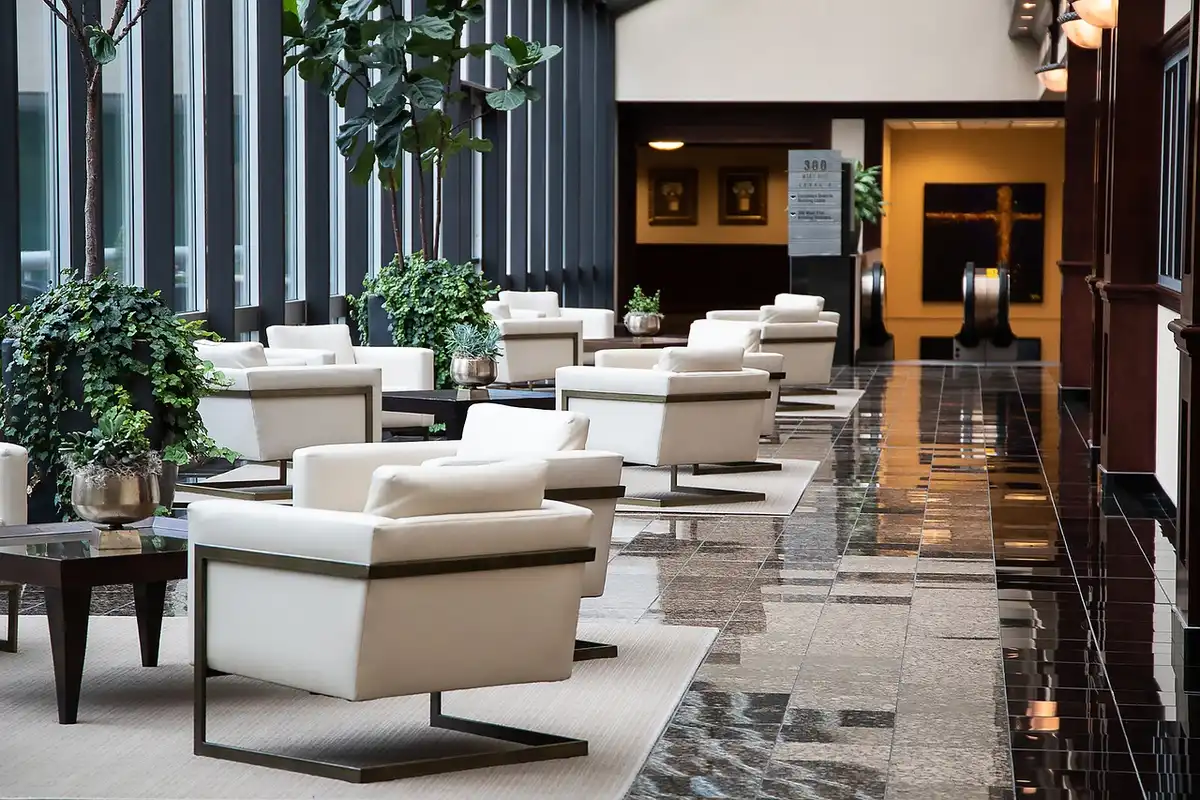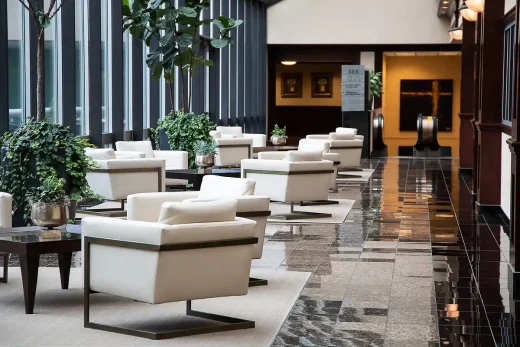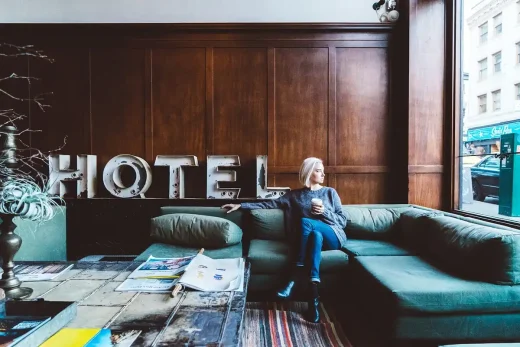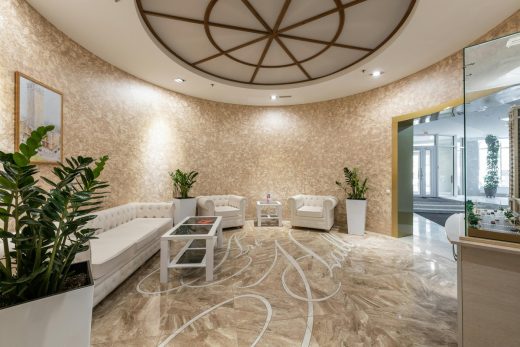Hospitality architecture and design role, Good hotel management with Les Roches
Hospitality Architecture and Design Role
27 June 2024
The Role of Architecture and Design in Hospitality
In the hospitality industry, the design and architecture of a space play a central role in shaping the guest experience. Every aesthetic detail contributes to their overall impression and satisfaction from the moment a guest steps into a hotel lobby to their time in their room. However, it’s the seamless collaboration between design teams and hotel management that ensures these spaces are both beautiful and functional. Effective hotel management translates thoughtful design into smooth operations, ensuring that spaces not only impress visually but also enhance the guest’s journey. This balance between design and management is essential for long-term business success, as showcased by institutions like Les Roches.
The Impact of Design on Guest Experience
Design Psychology
To create areas that resonate with guests on a subconscious level, understanding design psychology is essential. The layout, materials and overall aesthetic of a space can significantly influence a guest’s emotions and perceptions. For instance, a well-designed, bright, airy foyer can evoke feelings of warmth and welcome, setting a positive tone for the rest of the stay. Organic elements like wood and stone can create a sense of connection with the environment, particularly in resorts where the natural surroundings are a key attraction.
Colour Psychology
Colours can influence mood and behaviour, and they are powerful tools in design. In hospitality settings, colour schemes can improve the guest experience by creating the desired atmosphere. For example, soothing blues and greens are often used in resorts to promote relaxation, while bright colours might be used in urban hotels to reflect the energy of the city. According to a study by the University of South Carolina, colour can affect up to 90% of a person’s initial impression of a space.
Spatial Layouts
The spatial arrangement of a hotel or resort is akin to a well-choreographed ballet, with each element contributing to a seamless guest experience. In resorts, integrating indoor and outdoor spaces facilitates a smooth transition between the natural and built environments. Gardens, pool areas and private retreats are designed to promote leisure and seclusion. In urban hotels, space is often at a premium, necessitating efficient layouts that maximise utility and encourage social interaction.
Creating Memorable Experiences Through Design
Engaging the Senses
A successful hospitality design engages all the senses. This can be achieved through soundscapes, lighting effects and fragrances that create a multi-sensory experience. For example, incorporating natural light and views of the surrounding area can significantly boost the guest experience by providing a connection to nature. Using ambient noise, such as gentle music or natural sounds, can also create a calming atmosphere that promotes relaxation.
Recreational Opportunities
Good hospitality architecture should offer recreational opportunities to augment the overall guest experience. Features like swimming pools, gardens and outdoor seating areas can allow guests to relax and enjoy their surroundings. These spaces add to the property’s aesthetic appeal and allow visitors a chance to unwind and rejuvenate.
Facilitating Well-being
Incorporating elements that promote well-being, such as rooftop gardens and natural light, can create a relaxing environment for guests. This improves the guest experience and aligns with the growing trend toward wellness tourism. Hotels prioritising well-being through thoughtful design can attract health-conscious travellers looking for a holistic experience.
Design Considerations in Hospitality Architecture
Space and Privacy
Ensuring ample space and privacy is essential. This can be achieved through thoughtful layout designs that provide enough room for guests to move around comfortably. Private balconies, secluded seating areas and soundproofing are some of the design elements that can strengthen privacy and create a more intimate experience.
Lighting and Ventilation
Essential components of hospitality design include natural lighting and ventilation. They not only augment the aesthetic appeal of the space but also contribute to the comfort and well-being of guests. Large windows, skylights and open-air courtyards can bring in light and fresh air, creating a bright and airy atmosphere.
Material Selection
Materials used in hospitality architecture should be durable and aesthetically pleasing, creating a welcoming environment while withstanding wear and tear. Sustainable, eco-friendly options such as reclaimed wood, recycled metal and low-VOC paints can also reflect a hotel’s commitment to environmental responsibility and increase the property’s sustainability.
Safety and Security
Safety is a paramount concern in hospitality design. This includes the use of fire-resistant materials, security features and energy-efficient systems. Ensuring compliance with local codes and regulations is also essential. Advanced options, such as keycard access and surveillance cameras, can improve guest safety and provide peace of mind.
The Future of Hospitality Architecture
Smart Technology
Integrating smart technology, such as automation and AI, will improve the guest experience. For instance, voice-activated personal assistants and facial recognition systems can provide personalised services and improve security. Smart room controls, such as automated lighting and climate control, can offer guests a more convenient and comfortable stay.
Data Analytics
When it comes to understanding customer preferences and optimising services, data analytics will play a key role. By collecting and analysing patron information, hotels can tailor their offerings to meet the specific needs of their guests. Predictive analytics can also help to anticipate trends and make informed decisions about design and amenities.
Sustainability
Hospitality architecture will continue to include a significant focus on sustainability. Incorporating energy-efficient systems, renewable sources and sustainable materials will reduce the environmental impact and appeal to eco-conscious travellers. According to the World Green Building Council, sustainable buildings can lower consumption by up to 50%.
Adapting to New Travel Behaviors Post-Pandemic
Safety and Hygiene
The COVID-19 pandemic has reshaped travel behaviours, necessitating hotel design and architecture changes. Safety, hygiene and flexibility have become top priorities. Hotels are adopting advanced cleaning technologies and touchless amenities to ensure guests remain safe. This includes the use of antimicrobial materials and air purification systems.
Flexible Spaces
The rise of remote jobs has increased the demand for flexible spaces. Hotels are incorporating work-friendly environments with robust internet connectivity and adaptable furniture. Multi-functional areas that can be easily reconfigured to accommodate different needs are becoming more popular.
Localised Experiences
With many travellers exploring closer-to-home destinations, hotels are integrating local cultural elements into their design. This gives guests an authentic experience and a sense of connection to the destination. Regional art, cuisine and traditions can be incorporated to create a unique and memorable stay.
Challenges and Solutions in Modern Hotel Construction
Integrating Technology
Planning for future technological advancements is essential. This involves collaborating with tech experts during the design phase to ensure the necessary infrastructure is in place. Hotels must stay ahead of the curve by adopting the latest technologies that add to the guest experience and improve operational efficiency.
Energy Efficiency
Adopting green building standards and incorporating renewable sources can significantly reduce a hotel’s environmental impact. This includes using energy-efficient systems and sustainable materials. Solar panels, energy-efficient lighting and water-saving fixtures are ways hotels can improve their sustainability.
Evolving Guest Preferences
Understanding and anticipating guest preferences is vital. This can be achieved through continuous research and feedback from guests. Based on this information, hotels must be adaptable and willing to change to stay competitive.
Conclusion
The role of architecture and design in hospitality is multifaceted and ever-evolving. These elements are vital in shaping the industry’s future, from creating memorable experiences to incorporating smart technology and sustainable practices. As we move forward, we will focus on establishing environments that promote comfort, well-being and unforgettable guest experiences.
By weaving in these insights and references, we ensure that the article is comprehensive and well-informed and engaging and valuable for readers interested in the role of architecture and design in hospitality.
Comments on this Hospitality architecture and design role article are welcome.
Luxury Hotel Architectural Design
Luxury Hotel Architectural Designs
NoMad London, 4 Bow Street, Covent Garden, central London, England, UK
Design: Roman and Williams
NoMad London Hotel, Covent Garden
Metric Hotel, Westlake community, Los Angeles, Southern California, USA
Design: Aaron Neubert Architects
Metric Hotel
Property
Contemporary Property Articles – architectural selection below:
Hotel Design and Hospitality Architecture
Hotel Buildings and Hospitality Architectural Design
Artists Enhance the Aesthetic of Luxury Hotel
Aspects That Make a Good Hotel Great
Comments / photos for the Hospitality architecture and design role page welcome.








